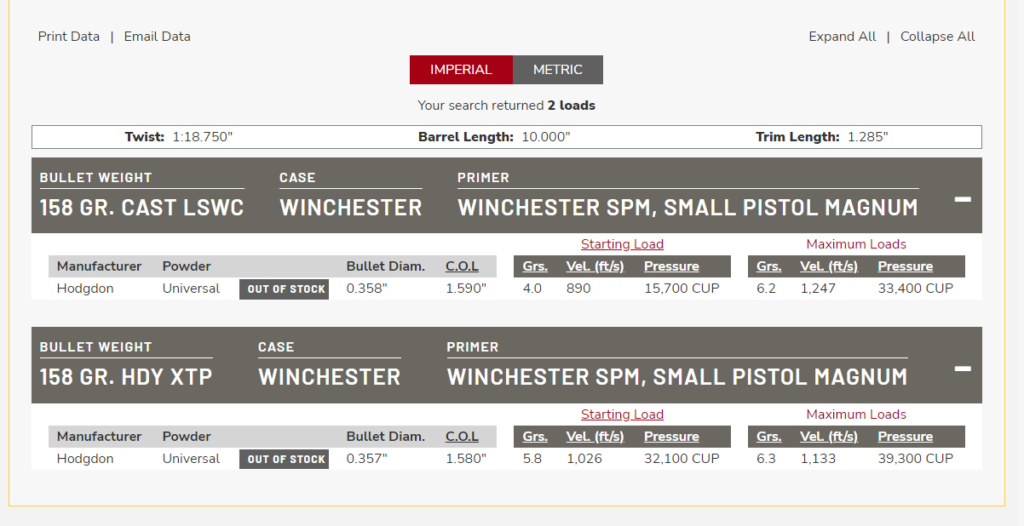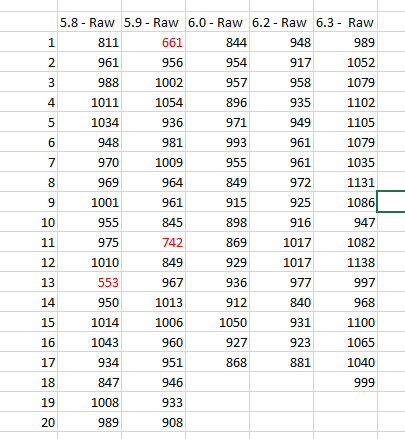If you listened to my podcast on Monday, then you got a sneak preview to what I was going to talk about today. After all of these years, I am finally getting around to testing some of my reloads. I needed/wanted some validation data before I resumed doing any further reloading.
Now, I don’t know if you have been aware of what has been going on the last couple of years but in case you have been in a hole, reloading components are really hard to find. Fortunately for me, I loaded this ammunition in 2017. The challenging part is that replacing it is going to be challenging with the lack of components. Listening to Gun Talk the other day, I heard that some powders won’t even be made for another year. Good luck finding primers too. Fortunately, I have some of both.
What was my setup? Well, here is my source for my loads, the Hodgdon website.

My starting point is the second line, but I included the first line for comparison. I can’t possibly inform all the nuances of reloading today but you should know pushing a lead bullet too fast can cause barrel fouling. I interchange bullets sort of willy-nilly as long as we are talking about the same type bullet construction. My rule is as long as the weight is the same and it is copper jacketed, it should be safe to load with published data. If using lead bullets, make sure you are not using jacketed load data to start with until you have some idea of what you are doing.
Not everything is perfect. The cases I used were mixed head stamp instead of Winchester, the bullet I used was a Speer 158gr hollow point instead of a Hornady XTP (also a jacketed hollow point) but the powder was Hodgdon Universal and the primers were Winchester.
I have another secret, I also mix and match primer brands with starting point loads. This is not an endorsed reloading best practice. You can find tables ranking primer ignition and granted, I am not an expert but we are in a time when you have to work with what you can get. My best guess is that you might effect accuracy or not be able to duplicate published data but I really have my doubts that changing primer brands is actually dangerous.
The way I initially choose my starting point loads was to cross compare powders that work across multiple cartridges. I also look at multiple sources, availability and so on and pick a direction. I literally wrote down a list of powders that would work and went to the store to see what they had. Lest you think that you can buy this stuff online – you can. But it has to ship under a specific HazMat banner so it costs quite a bit more for small quantities. Purchasing local is almost always the best deal, but again this is a matter of getting it or not.
I load 100 cartridges at a time. So in this case, I loaded 20 – 5.8 grains, 20 – 5.9 grains, 20 – 6.0 grains, 20 – 6.2 grains and 20 – 6.3 grains. I fired all of them and measured the velocity. I am working on my 1000 round trigger job concept and my rifle is not even sighted in so I just shot for velocity measurement.
There are two other variables to consider. One is the barrel length. Mine was fired out of a Rossi 92, 16 inch barrel. In theory, this should give the highest possible velocity compared to a shorter barrel. You can see the published load used a ten inch barrel. The other is the outside temperature. This day was a smoky 80 degrees. In theory, the warmer the outside temperature, the more velocity you are going to get. It has to do with the theory of reaction, gas/pressure etc. You don’t want any more science today.
Without further adieu, here is the raw data.

Since I have given you all of the tools to calculate the results, you can go ahead of me if you like. I am going to save the analysis for next week and I will let you in on a secret, I am withholding some information that will be helpful on my overall prognosis. Nevertheless, what is presented is the basic starting point looking at the data.
You did listen to my podcast on Monday didn’t you? You will see that I have some values highlighted in red Those to me are the outliers. You will also notice that I have some blanks, those were the results of missing the chronograph. Since you listened, you know my theory and how I am going to handle them next week. I will give you this week to catch up and listen to the podcast.
End Your Programming Routine: This is the culmination of years of kind of stumbling around in the dark. My next planned range trip I have a very similar exercise planned with a different powder. As a scientist, I can only make educated decisions with data. I don’t know how far I can actually take this given today’s shortages but I will probably have enough data to decide to keep looking at components or work on dialing the current ones in.
Recent Comments